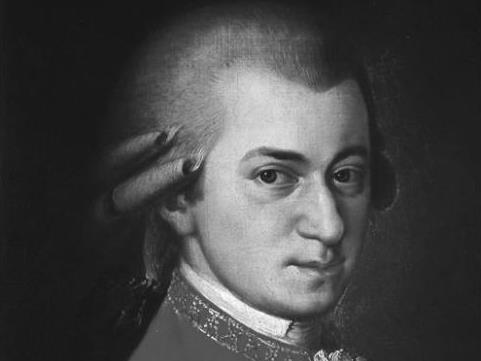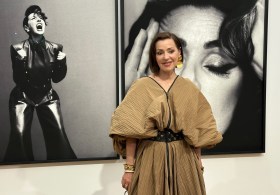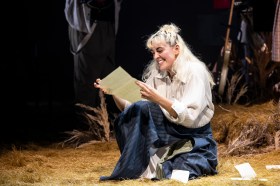Image: Mozart via MSO.
The sold-out third concert in the MSO’s current Mozart Festival featured two works written in 1791,the composer’s final year, (La clemenza di Tito: Overture, K 621 and the Clarinet Concerto, K 622), as well as the Requiem, K 626, which was left unfinished. The latter composition has undoubtedly become one of the most famous and loved choral works, generally regarded as Mozart’s own leave-taking of the world. Yet, it was hurriedly given a plausible completion, initially by Joseph von Eybler and then by Mozart’s student, Franz Xaver Süssmayr. There was some urgency to deliver the composition to its commissioner Franz von Welsegg so that Mozart’s widow could receive the final half-payment of the commission. The composite score was fraudulently presented two months after the composer’s death as entirely Mozart’s work, complete with counterfeited signature. Its deficiencies are transparent to anyone familiar with Mozart’s oeuvre. The Sanctus is little more than a puerile fanfare in D major. The recapitulation of musical material in the Agnus Dei and final Communio are blatant and laboured. Some scholars have urged that the work should end where Mozart left it, after the eighth bar of the Lacrimosa only half-way through the composition. However, faults and all, the von Eybler/Süssmayr ‘completion’ used for this performance has come to be accepted as the standard version.
The brief La clemenza di Tito: Overture, K 621, first performed in Prague in September 1791, bristling with energy and with stacks of bluster and flourish, provides no hint that the composer’s life was to end just three months later. His commissioning fee for the opera was double what he would normally expect in Vienna but the catch was that it needed to be written at great speed (in two months) to celebrate the coronation of Leopold II, Holy Roman Emperor, as King of Bohemia. Here its Overture was given plenty of throttle by director Richard Egarr. Neat counterpoint revealed an ensemble that was far more settled than the last instalment in this Festival a week ago. With satisfying, thumping timpani it provided the excited expectation of a grand-scale opera opening.
The Clarinet Concerto, K 622 was written the following month in October, 1791 for a performance, also in Prague, by the clarinettist Anton Stadler. The original score no longer exists. The work’s most convincing reconstruction calls for an extended-range basset clarinet, the version that was performed here. The excellent soloist was David Thomas, principal clarinet of the Melbourne Symphony Orchestra. The opening Allegro, though, could have enjoyed a more certain rapport between soloist and ensemble and a clearer shared recognition of form. This is not an extroverted concerto. It demands a shared intimacy of material almost as if it were a chamber music composition. The vocal breathiness of the beautiful Adagio delighted, as did the deep sonorities of the instrument within this movement. This famous music speaks as a statement of gracious finality, the lovely sotto voce recapitulation being a pleasure to savour. With burbling arpeggios, the delicately chirpy final Rondo was most elegantly conveyed. In sum a fine achievement, particularly for Thomas.
The 80-voice Melbourne Symphony Chorus (well trained by guest chorus master, Warren Trevelyan Jones) performed the Requiem with acumen, style and balance, always responsive to Richard Egarr’s interesting and sometimes idiosyncratic interpretation. Tuning and rapport were excellent throughout, with particularly good-quality vocal sound coming from its young soprano section. Pronunciation of Latin with clear and clean articulation of consonants demonstrated evidence of polish and fine attention to detail in preparation.
The Introitus suffered an unsteady start with a lagging pair of basset horns (unnamed in the printed program) recovered by well-articulated and shaped counterpoint in the Kyrie. The Sequentia (with text based on the Dies Irae) revealed a frenetic energy with, once again, brilliant timpani playing by guest musician, Guy du Blêt. Rex tremendae with its splendid, unison-rolled ‘r’s by the chorus was followed by the Recordare with its lovely duetting of basset horns and cascading strings. The damning Confutatis was truly brutal but the Lacrymosa could have expressed a greater ache.
The turbulent Agnus Dei was pleasingly free from the usual pleading histrionics associated with the movement, except for an overdone crescendo and pause over the phrase dona eis requiem sempiternam. I was also unconvinced by the final utterance es left separated and forced. The trio of trombones was excellent throughout.
Soloists on the night were mostly commendable. Well-known soprano Sara Macliver who specialises in Baroque and Classical repertoire warmed as the concert progressed. Fiona Campbell gave a reliable and attractive account of her material. Tenor Andrew Goodwin was thorough and engaging, but my concern was with bass Christopher Richardson who lacked depth and resonance, and demonstrated unevenness throughout his range. But as a quartet the blend was fine in the Benedictus.
Rating: 4 stars out of 5
Mozart’s Requiem
MSO Mozart Festival
Melbourne Symphony Orchestra
Richard Egarr, conductor
David Thomas, basset clarinet
Sara Macliver, soprano
Fiona Campbell, mezzo-soprano
Andrew Goodwin, tenor
Christopher Richardson, bass
Melbourne Symphony Orchestra Chorus
Hamer Hall, Arts Centre Melbourne
Friday, 21 July, 2017





